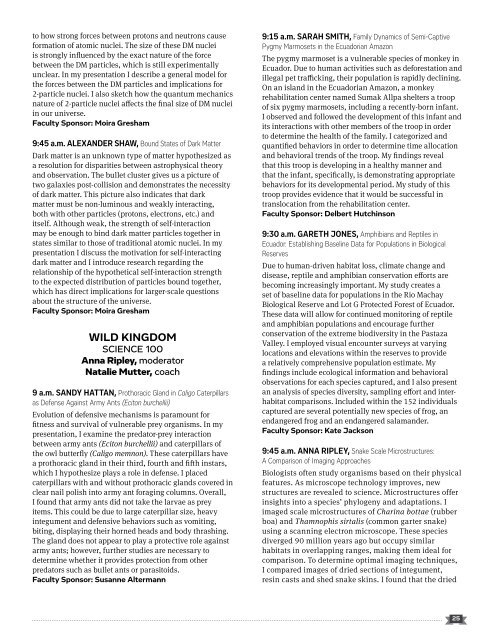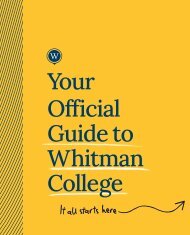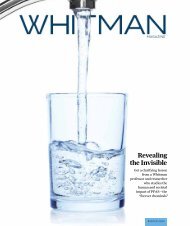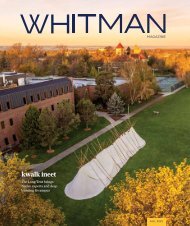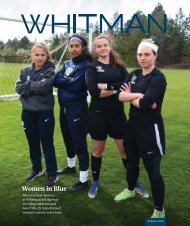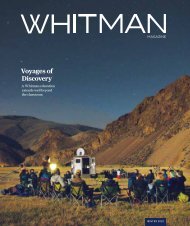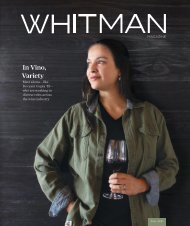Create successful ePaper yourself
Turn your PDF publications into a flip-book with our unique Google optimized e-Paper software.
to how strong forces between protons and neutrons cause<br />
formation of atomic nuclei. The size of these DM nuclei<br />
is strongly influenced by the exact nature of the force<br />
between the DM particles, which is still experimentally<br />
unclear. In my presentation I describe a general model for<br />
the forces between the DM particles and implications for<br />
2-particle nuclei. I also sketch how the quantum mechanics<br />
nature of 2-particle nuclei affects the final size of DM nuclei<br />
in our universe.<br />
Faculty Sponsor: Moira Gresham<br />
9:45 a.m. ALEXANDER SHAW, Bound States of Dark Matter<br />
Dark matter is an unknown type of matter hypothesized as<br />
a resolution for disparities between astrophysical theory<br />
and observation. The bullet cluster gives us a picture of<br />
two galaxies post-collision and demonstrates the necessity<br />
of dark matter. This picture also indicates that dark<br />
matter must be non-luminous and weakly interacting,<br />
both with other particles (protons, electrons, etc.) and<br />
itself. Although weak, the strength of self-interaction<br />
may be enough to bind dark matter particles together in<br />
states similar to those of traditional atomic nuclei. In my<br />
presentation I discuss the motivation for self-interacting<br />
dark matter and I introduce research regarding the<br />
relationship of the hypothetical self-interaction strength<br />
to the expected distribution of particles bound together,<br />
which has direct implications for larger-scale questions<br />
about the structure of the universe.<br />
Faculty Sponsor: Moira Gresham<br />
WILD KINGDOM<br />
SCIENCE 100<br />
Anna Ripley, moderator<br />
Natalie Mutter, coach<br />
9 a.m. SANDY HATTAN, Prothoracic Gland in Caligo Caterpillars<br />
as Defense Against Army Ants (Eciton burchellii)<br />
Evolution of defensive mechanisms is paramount for<br />
fitness and survival of vulnerable prey organisms. In my<br />
presentation, I examine the predator-prey interaction<br />
between army ants (Eciton burchellii) and caterpillars of<br />
the owl butterfly (Caligo memnon). These caterpillars have<br />
a prothoracic gland in their third, fourth and fifth instars,<br />
which I hypothesize plays a role in defense. I placed<br />
caterpillars with and without prothoracic glands covered in<br />
clear nail polish into army ant foraging columns. Overall,<br />
I found that army ants did not take the larvae as prey<br />
items. This could be due to large caterpillar size, heavy<br />
integument and defensive behaviors such as vomiting,<br />
biting, displaying their horned heads and body thrashing.<br />
The gland does not appear to play a protective role against<br />
army ants; however, further studies are necessary to<br />
determine whether it provides protection from other<br />
predators such as bullet ants or parasitoids.<br />
Faculty Sponsor: Susanne Altermann<br />
9:15 a.m. SARAH SMITH, Family Dynamics of Semi-Captive<br />
Pygmy Marmosets in the Ecuadorian Amazon<br />
The pygmy marmoset is a vulnerable species of monkey in<br />
Ecuador. Due to human activities such as deforestation and<br />
illegal pet trafficking, their population is rapidly declining.<br />
On an island in the Ecuadorian Amazon, a monkey<br />
rehabilitation center named Sumak Allpa shelters a troop<br />
of six pygmy marmosets, including a recently-born infant.<br />
I observed and followed the development of this infant and<br />
its interactions with other members of the troop in order<br />
to determine the health of the family. I categorized and<br />
quantified behaviors in order to determine time allocation<br />
and behavioral trends of the troop. My findings reveal<br />
that this troop is developing in a healthy manner and<br />
that the infant, specifically, is demonstrating appropriate<br />
behaviors for its developmental period. My study of this<br />
troop provides evidence that it would be successful in<br />
translocation from the rehabilitation center.<br />
Faculty Sponsor: Delbert Hutchinson<br />
9:30 a.m. GARETH JONES, Amphibians and Reptiles in<br />
Ecuador: Establishing Baseline Data for Populations in Biological<br />
Reserves<br />
Due to human-driven habitat loss, climate change and<br />
disease, reptile and amphibian conservation efforts are<br />
becoming increasingly important. My study creates a<br />
set of baseline data for populations in the Rio Machay<br />
Biological Reserve and Lot G Protected Forest of Ecuador.<br />
These data will allow for continued monitoring of reptile<br />
and amphibian populations and encourage further<br />
conservation of the extreme biodiversity in the Pastaza<br />
Valley. I employed visual encounter surveys at varying<br />
locations and elevations within the reserves to provide<br />
a relatively comprehensive population estimate. My<br />
findings include ecological information and behavioral<br />
observations for each species captured, and I also present<br />
an analysis of species diversity, sampling effort and interhabitat<br />
comparisons. Included within the 152 individuals<br />
captured are several potentially new species of frog, an<br />
endangered frog and an endangered salamander.<br />
Faculty Sponsor: Kate Jackson<br />
9:45 a.m. ANNA RIPLEY, Snake Scale Microstructures:<br />
A Comparison of Imaging Approaches<br />
Biologists often study organisms based on their physical<br />
features. As microscope technology improves, new<br />
structures are revealed to science. Microstructures offer<br />
insights into a species’ phylogeny and adaptations. I<br />
imaged scale microstructures of Charina bottae (rubber<br />
boa) and Thamnophis sirtalis (common garter snake)<br />
using a scanning electron microscope. These species<br />
diverged 90 million years ago but occupy similar<br />
habitats in overlapping ranges, making them ideal for<br />
comparison. To determine optimal imaging techniques,<br />
I compared images of dried sections of integument,<br />
resin casts and shed snake skins. I found that the dried<br />
25


